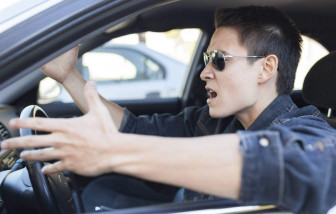
Name: Kiara Stephanie Gill
From: Aurora, Colorado
Votes: 0
I was eight years
old when I saw my first road rage incident. Another car drove
dangerously next to us as our lane was ending and refused to let us
in. After taking evasive action, my dad stuck his head out the
window, yelled at the driver and showed him an obscene gesture. This
is described as aggressive driving or road rage. According to the
American
Automobile Association (AAA), aggressive driving
is described as “the operation of a motor vehicle in a manner that
endangers or is likely to endanger persons or property.” Aggressive
behavior includes actions such as, honking, tailgating, yelling,
making angry gestures, cutting off a vehicle, preventing a vehicle
from changing lanes, and speeding. The AAA estimates that 80% of
drivers express aggression or road rage once per year. They estimate
that half of all fatal accidents were associated with aggressive
driving. Aggressive driving has seen an increase in the last twenty
years, particularly due to the anonymity we have while driving.
Because of the sudden increase in aggressive driving, officials are
looking for ways to reduce and prevent aggressive driving. The AAA
has recommended a few practical solutions.
-
Be aware
for your stress levels, the more stressed out you are, the more
likely they are to drive aggressively. -
Leave home
early, scheduling issue can cause you to speed to get to places on
time. -
Listen to
soothing music or audiobooks, even taking a deep breath can help
prevent aggressive driving. -
Be
tolerant and forgiving -
Don’t
respond. Avoid eye contact, don’t make gestures, and call 911 if
needed.
All these points are good starting points for preventing road rage,
however, it doesn’t focus on ways we can prevent road rage in the
first place. Road rage is usually caused by poor driving or errors.
For example, using a phone while driving, keeping your high beams on,
switching lanes without a turn signal, or accidently cutting someone
off. Distracted driving is a direct cause of aggressive driving. One
idea I have for reducing driving errors is for drivers to learn car
control in a safe environment in the sport of autocrossing; an
activity I often attend with my dad.
Autocrossing is a
safe way to learn car control. Drivers compete for fastest time on a
course lined by cones at speeds similar to normal driving. There is a
2 second penalty for hitting a cone so precision driving is needed.
Some skills you learn are:
-
Car setup
and handling characteristics -
Car limits
in safe environment -
Driving
accuracy -
Car upset
control -
Acceleration
and braking skills -
Car skid
control
You also get that
need for speed fulfilled safely. I am working towards becoming an
autocross driver and learning these skills by training with my dad.
These defensive driving skills will help me to improve my situational
awareness and prevent common errors that cause road rage. If every
driver learns these skills, aggressive and distracted driving can be
prevented, resulting in safer roads.
https://aaafoundation.org/prevalence-self-reported-aggressive-driving-behavior-united-states-2014/